Kenya islanders rehabilitate their environment, and their lives
Loading...
| RUSINGA ISLAND, Kenya
For the past 16 years, Ester Evelyn Odhiambo has dedicated herself to improving life on one small island. It’s no small task.
Rusinga Island, in the northeast corner of Lake Victoria in Kenya, is about 16 km (10 miles) long and 5 km (3 miles) wide. About 30,000 people call it home. But the island over the years has become an increasingly inhospitable environment for them.
“If you plant something, it just dries out,” says Ms. Odhiabmo, who runs an organization to help people widowed or orphaned by AIDS. “You try to irrigate, and the water is too little because the sun comes and dries everything.”
The changes have come because of poor management of resources – including forests and fishing grounds – and because of increasing climate impacts.
RELATED: Obama vs. Romney 101: 4 ways they differ on climate change
But now residents are experimenting with renewable energy innovations, environmentally friendly farming, tree planting, and other efforts aimed at improving the island’s environment, building resilience, creating livelihoods, and overcoming shortages of food and water.
Fishing used to be the major source of livelihood for people on Rusinga. But over time, the fish in the waters surrounding the island disappeared as a result of overfishing, changing water temperature, and siltation from tree cutting and land clearing for agriculture.
“You can just see around. We don’t have any trees on the land,” said Evans Odula, the director of Badilisha, a local NGO whose name in Kiswahili means “change.”
According to Odula, the island’s trees were felled mainly to provide fuel in homes and for smoking fish. But there were no efforts to plant replacements.
The loss of trees worsened the island’s already dry climate, Odula said.
“This place is drought-prone,” he said. “We have very short rains, and the normal weather patterns have changed ... which has led to food shortages and poverty.”
The island receives only four months of rain a year, Odula said.
To deal with the worsening problems, Odula now trains farmers in permaculture (permanent agriculture), a concept that originated in Australia.
Odula describes it as “a way of farming where people are able to provide food throughout the year while protecting the environment.”
“We are trying to see people do farming that is eco-friendly and [with] no use of chemicals,” he said. “[We teach] eco-friendly activities that promote good soil, plants, and organisms, and biological ways of pest control.”
On the compound where Badilisha trains farmers there are fodder trees, crops, animal sheds, and water-harvesting tanks. The shade of the trees is cooling, and Odula points out the benefits of the lucerne tree.
“It provides shade [as well as] fodder for the animals, and at the same time firewood,” he said.
Shem Orwa Anditi, a member of one of Badilisha’s self-help groups for farmers, now practices permaculture.
“We are growing cabbages, kale, and tomatoes,” the 63-year-old said. “We don’t use any chemical fertilizer, just compound manure. We don’t burn anything in the farm. We use [plant waste] for mulching, which keeps water in the soil.”
Anditi, a retired civil servant, now is able to grow enough vegetables to sell, as well as being able to feed his family.
“The climate now has changed,” Anditi said. “Where we are standing now was [once] too dry. The project has made us understand that planting trees can make somewhere very cool.”
Farmers are encouraged to use water-harvesting tanks to capture water during the rainy seasons, which can then be used to get them through dry periods. Efforts also have begun to pump water from the lake for irrigation.
In order to keep their new abundance of produce fresh, some farmers have begun using a type of refrigerator that uses locally available materials and requires no electricity. It is lined with charcoal, into which water seeps through a hosepipe fed by a bucket. The wet charcoal absorbs heat and keeps the items inside the fridge cool.
Each fridge costs about 5,000 Kenyan shillings ($59), which makes it affordable to most farmers, according to Odula.
Odhimabo says a shortage of water to irrigate crops is the major cause of poverty on the island. Water tanks remain unaffordable for some, and homes with thatched roofs cannot harvest rainwater effectively.
But unclean drinking water is also a problem, leading to illness and expensive medical bills. KISIBOM, Odihambo’s NGO (the name means “come and learn” in Kiswahili), is promoting solar water disinfection to help provide safe supplies.
Waterborne organisms that cause diarrhea and other diseases can be killed simply by exposing them at the right temperature to ultraviolet rays in sunlight, Odihambo said. Plastic containers are filled with water and left in the sun. To speed the warming process and retain the heat, the bottles are painted black on one side and placed on a black-painted iron sheet.
“After five to eight hours, there will be no micro-organisms in the water and it will be ready and safe for drinking,” explained Odhiambo.
The same results can be achieved by leaving 20-liter (5 gallon) jerry cans in the sun for one week, she said.
Renewable energy – and energy conservation – is being used wherever possible. Odhiambo’s compound is designed to reduce costs and environmental impact. An energy-saving stove is used to prepare meals for the orphans who live at the school there, the staff who look after them, and the groups of widows who make handicrafts for a living.
A solar system provides light in the kitchen, offices, and classrooms. The trees around the compound provide shade, which is welcome when workshops spill outside from the training hall.
• Pius Sawa is a freelance science journalist based in Nairobi, Kenya.
• This article originally appeared at AlertNet, a humanitarian news site operated by the Thomson Reuters Foundation.
• Sign up to receive a weekly selection of practical and inspiring Change Agent articles by clicking here.







